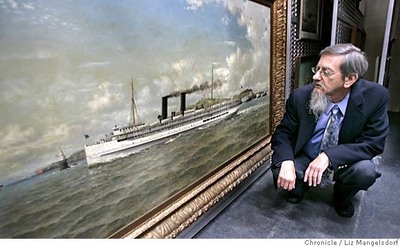 The Paul and Linda Kahn Foundation History, Education, the Arts & Religion
The Paul and Linda Kahn Foundation History, Education, the Arts & Religion
 The Paul and Linda Kahn Foundation History, Education, the Arts & Religion
The Paul and Linda Kahn Foundation History, Education, the Arts & Religion
SAN FRANCISCO / Coulter's ships may come in / Maritime museum seeks artist's paintings, sketches for 2006 show
By Carl Nolte Published 4:00 am, Monday, July 4, 2005, http://www.sfgate.com/bayarea/article/SAN-FRANCISCO-Coulter-s-ships-may-come-in-2657948.php
 David Hull, Principal Librarian, SF Maritime NHP Library
David Hull, Principal Librarian, SF Maritime NHP Library
SAN FRANCISCO / Coulter's ships may come in / Maritime museum seeks artist's paintings, sketches for 2006 show
A major search is under way for the missing works of William A. Coulter, a renowned San Francisco maritime artist.
Coulter, who painted and sketched for 67 years, was a witness to "the most significant change in the history of seafaring -- the shift from sail to steam," said David Hull, principal librarian at the San Francisco Maritime National Historical Park, which is organizing the first ever retrospective of Coulter's work.
Coulter's world was the sea and ships, particularly the traffic on San Francisco Bay. It was a turn-of-the-last-century world of whalers and fishing boats, tugs and revenue cutters. He worked in what art historian Marcus De Chevrieux called San Francisco's "golden era of maritime prominence." He lived in Sausalito. And he died in spring 1936, full of years, honors and memories.
Hull and De Chevrieux, who is curating the exhibit, hope to open the show at the park's visitor center at Aquatic Park next April, for the 100th anniversary of the 1906 earthquake.
They want to show the whole range of Coulter's work -- but they have a problem. The locations of dozens, maybe hundreds, of Coulter's paintings and drawings are unknown. The works are in the hands of collectors, of corporations and of ordinary people who admire pictures of old ships.
There may be as many as 200 Coulter works in private hands, said Tom Coulter, a retired Berkeley business executive who is William Coulter's grandson.
William Coulter was a commercial artist who supported his family by his art. "He painted prolifically," said Tom Coulter. "He was very facile."
Coulter sometimes sold his paintings at exhibitions and sometimes worked on commission for ship owners or captains. He worked for 10 years as a newspaper sketch artist for the old San Francisco Call in the days when newspaper photography was in its infancy. He even occasionally sold his sketches on street corners.
He had his first exhibition in San Francisco in 1874 when he was 25, and his last in 1934, when he was 85. At that final show, he offered 75 paintings on marine subjects. And he painted until the end.
"He had a painting on his easel when he died," Tom Coulter said.
William Coulter may have produced 1,000 paintings. He did perhaps 5,000 drawings for the Call. He was paid $5 each for them; sometimes three ran in a single day.
The 1906 earthquake and fire ended his newspaper career. With the city in ruins, freelance newspaper artists were a luxury, so Coulter was let go; he made a point to include the fire engulfing the Call building when he painted that catastrophe -- a 10-foot-long work in oil showing the city burning from the viewpoint of a boat in the bay.
He lived in Texas for a while, then returned to San Francisco to do a group of 13 paintings inside the Merchants Exchange building on California Street. At the time, the 16-story building was among the tallest west of the Mississippi. Lower California Street was headquarters for most of the shipping business on the Pacific Coast, and the Merchant Exchange trading floor was the center of it all. The 1906 fire had heavily damaged the building; when it was rebuilt, architect Julia Morgan designed the trading hall, and Coulter did the paintings that still line the room, which now houses a bank.
All of his maritime work shows technical mastery; Coulter had been an able seaman in his youth, and he always made a point to get the ships' sails and rigging exactly right.
He was a familiar figure in Sausalito, where he lived at Fourth and Valley streets, and on San Francisco's waterfront, where he appeared nearly every day, a small man with a Van Dyke beard, wearing a nautical cap and a tie, carrying a sketchbook or a painting under his arm.
He was a gentleman artist with a wife and family; he went to church in Sausalito every Sunday. With a limp left over from breaking his ankle in his youth, he carried a cane "in the classical way -- with style," his son James recalled.
"Coulter painted the ships he knew and loved as they were gradually disappearing from the world's oceans," De Chevrieux wrote in an overview of the planned exhibition. "Today, of course, almost all are gone, and many are remembered only as a result of Coulter's unique visual chronicle."
In his time, Coulter was well known. In 1943, seven years after his death, a Liberty ship named for him was launched at the Kaiser Shipyard in Richmond.
Anyone with information about Coulter paintings should get in touch with the San Francisco Maritime National Historical Park, Fort Mason, San Francisco, CA 94123.